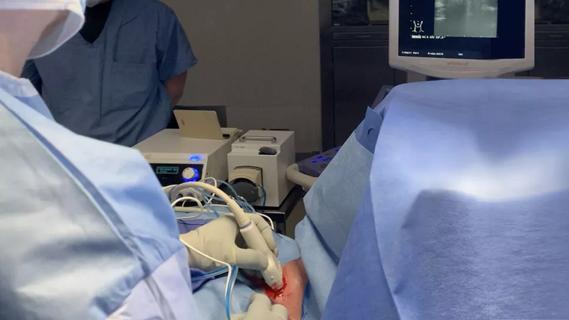Program enhances cooperation between traditional and non-pharmacologic care

As a pain management specialist, Richard Rosenquist, MD, uses tools such as medication, injections, physical therapy, psychological approaches and neuromodulation to treat patients with refractory pain. But he also knows how influential non-pharmacologic medicine and lifestyle changes can be when it comes to patients reclaiming lost function.
Advertisement
Cleveland Clinic is a non-profit academic medical center. Advertising on our site helps support our mission. We do not endorse non-Cleveland Clinic products or services. Policy
“In pain management, medications control symptoms rather than fix a problem,” says Dr. Rosenquist. “But if you can get people to exercise, modify their sleep, change their diet or stop smoking, many times those lifestyle changes will have a significant impact on underlying issues.”
In January 2023, Cleveland Clinic launched a referral option for non-pharmacologic pain management in its Epic electronic charting system and opened a Holistic Pain Management center on its main campus in Cleveland. Two more centers are expected to open at other Northeast Ohio sites this year, and wellness services are also delivered throughout the region through virtual and in-person visits.
The move grew out of cooperation between Dr. Rosenquist, Chair of Pain Management, and Robert Saper, MD, a family medicine physician with a special interest in complementary medicine. Dr. Saper joined Cleveland Clinic in 2021 as Chair of Wellness & Preventive Medicine. Working in cooperation with each other makes good sense.
For patients in pain, says Dr. Rosenquist, “there are things I can do, but there are a whole bunch of things that only they can do on behalf of their own wellness. So having an approach that includes these nonpharmacologic interventions to help with those things, and to do it with a single referral, is exciting.”
While wellness services have been available for 10 years, the new program streamlines the care, says Irina Todorov, MD, a specialist in both family and integrative medicine.
Patients who are referred to Holistic Pain Management begin with a consultation, after which their physician builds a plan that may include any number of interventions, including physical therapy, yoga, massage, chiropractic care, biofeedback and mind-body counseling around pain.
Advertisement
“Acupuncture also has great evidence,” says Dr. Todorov. “There’s very strong data supporting the efficacy of acupuncture for headaches, back pain and neck pain, which is why many insurance companies cover acupuncture specifically for those medical conditions.”
Emotional support is a key factor.
“There is pain, and there is suffering. For many people, I can’t change the pain, but I can change the perception of suffering,” she says. “When you ask people what kinds of quality-of-life changes they want when they seek help for chronic pain, they say they want to play with their grandkids. They want to do the things they like to do. The importance of improvement in intensity and frequency of pain rank lower compared to improvements in functionality. We need to address not only the physical but also the social and emotional aspect of chronic pain.”
The program employs social workers trained in guided imagery to deliver mind-body care.
“Many holistic psychotherapy providers do cognitive behavioral therapy,” says Dr. Todorov. “Specifically for this program, we developed a series of four individual visits that deliver specific guided imagery around pain issues. So each visit includes therapy as well as an experiential 20-minute session of guided imagery. This can be done in person or virtually.”
The department also conducts shared medical appointments, including a 90-minute class called “Living Well with Chronic Pain.” This is a five-visit, in-person course that includes information about acupuncture, nutrition coaching and holistic psychotherapy. The physician explains what chronic pain is and reviews information on supplements, sleep and exercise. A chiropractor speaks about posture. After a 15-minute chair yoga, patients receive acupuncture and guided medication.
Advertisement
When it comes to prioritizing a patient’s multiple goals, Dr. Todorov takes the lead from patients based on their own motivation.
“I ask what the patients want to work on first. If they say that they want to work on their diet, we start with dietary changes first,” she says. “If they say that the pain is preventing them from thinking about anything else, we’ll start with the group pain class, or with acupuncture. It’s important to find the patient’s internal motivation. They might not be ready to quit smoking. But if we start with what they’re willing to do, we can keep the communication going.”
Historically, one of the barriers to wellness services has been cost; some therapies have been covered by insurance while others have not. While this is still true, as evidence of efficacy has grown, more is now covered, says Dr. Todorov. Clinicians who aware of those changes are in a better position to counsel their patients on options.
For some chronic pain patients, a combination of holistic and pharmacologic interventions might be warranted, says Dr. Rosenquist. Somebody with severe diabetic neuropathy who uses wellness therapies to help them achieve glucose control, lose weight and exercise, might still require gabapentin to manage the pain so they can sleep.
“But overall, the efforts they make can dramatically improve their function,” he says. “They’re not going to have as high a risk for kidney disease or heart disease, because they’ve managed their health and they are probably managing their pain better, too.”
Advertisement
Success with one intervention also can have a cascading effect, he adds. “You might have somebody who has been managed with all sorts of medicines and hasn’t gotten where they wanted. You keep saying, ‘Do the exercise,’ but they don’t do it. Then they go to Holistic Pain Management and they get a psychologist or an acupuncturist involved. They started buying in, and then begin to do some of the other things that they needed to do,” he says.
The aim, he adds, is to offer sufficient support so patients take charge of their own health destiny.
“When patients begin to manage their condition instead of their condition managing them all the time, it’s a big step forward.”
Advertisement
Advertisement

Add AI to the list of tools expected to advance care for pain patients

Radiofrequency ablation significantly reduces symptom severity, shrinks nodules

Telehealth aids in treatment of fibromyalgia and median arcuate ligament syndrome

A surgeon’s perspective: three patient groups

Compassion, communication and critical thinking are key

Cleveland Clinic study investigated standard regimen

Despite the condition’s debilitating, electric shock-like pain, treatment options are better than ever

Program participation correlates with reduced use of opioids, X-rays and ED visits